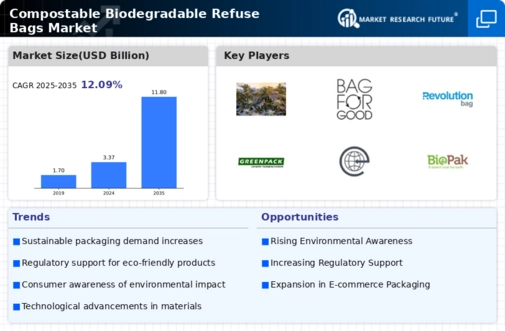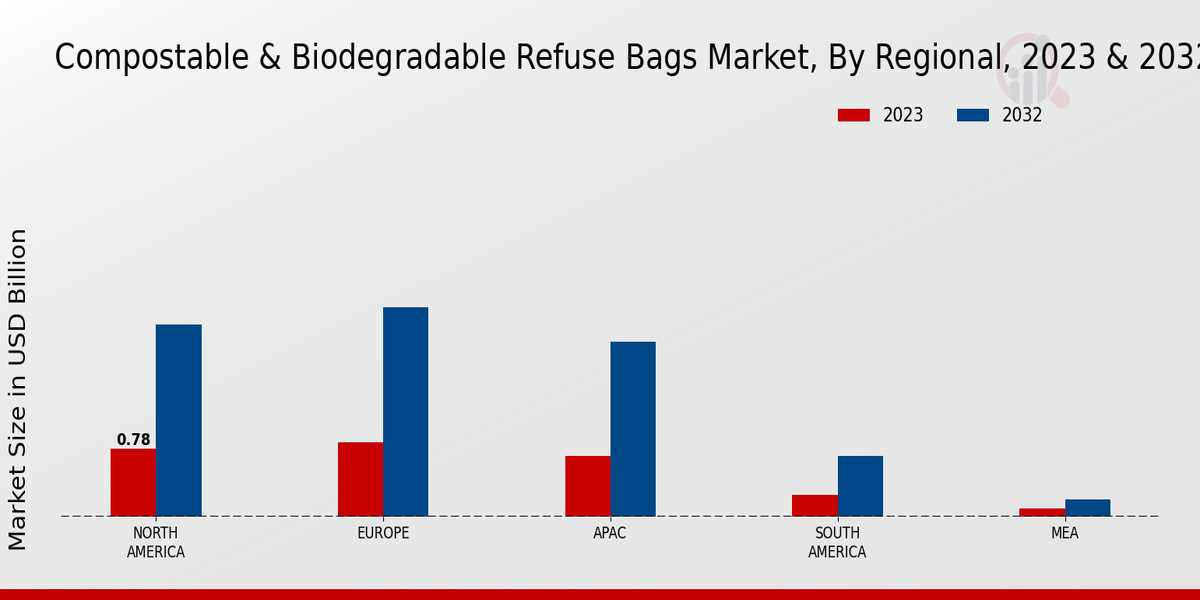Rising Environmental Awareness
The Global Compostable Biodegradable Refuse Bags Market Industry experiences growth driven by increasing environmental awareness among consumers and businesses. As individuals become more conscious of their ecological footprint, there is a notable shift towards sustainable products. This trend is reflected in the rising demand for compostable refuse bags, which are perceived as a viable alternative to traditional plastic bags. For instance, many municipalities are implementing regulations that encourage or mandate the use of biodegradable options. This heightened awareness is expected to contribute significantly to the market, with projections indicating a market value of 3.37 USD Billion in 2024.
Government Regulations and Policies
Government regulations play a pivotal role in shaping the Global Compostable Biodegradable Refuse Bags Market Industry. Numerous countries are enacting legislation aimed at reducing plastic waste, which directly impacts the demand for compostable refuse bags. For example, bans on single-use plastics in various regions have led to an increased reliance on biodegradable alternatives. Such regulatory frameworks not only promote environmental sustainability but also create a favorable market environment for compostable products. The anticipated growth in this sector is underscored by a projected market value of 11.8 USD Billion by 2035, reflecting the long-term impact of these policies.
Corporate Sustainability Initiatives
Corporate sustainability initiatives are becoming a driving force in the Global Compostable Biodegradable Refuse Bags Market Industry. Many companies are adopting environmentally friendly practices, including the use of compostable refuse bags in their operations. This shift is often part of broader corporate social responsibility strategies aimed at reducing waste and promoting sustainability. As businesses recognize the importance of aligning with consumer values, the demand for compostable products is likely to increase. This trend is expected to contribute to the market's growth, with projections indicating a market value of 11.8 USD Billion by 2035.
Consumer Demand for Sustainable Products
The Global Compostable Biodegradable Refuse Bags Market Industry is propelled by a growing consumer demand for sustainable products. As eco-consciousness rises, consumers increasingly seek alternatives that align with their values. This shift is evident in retail environments where compostable refuse bags are becoming more prevalent. Retailers are responding to this demand by offering biodegradable options, thereby enhancing their product lines. This trend is not only beneficial for the environment but also presents a lucrative opportunity for manufacturers. The market's expansion is expected to be substantial, with projections indicating a market value of 3.37 USD Billion in 2024.
Technological Advancements in Material Science
Technological advancements in material science are significantly influencing the Global Compostable Biodegradable Refuse Bags Market Industry. Innovations in biodegradable materials, such as the development of new polymers and additives, enhance the performance and durability of compostable bags. These advancements not only improve the functionality of the products but also address consumer concerns regarding their effectiveness compared to traditional plastic bags. As manufacturers adopt these new technologies, the market is likely to witness accelerated growth. The compound annual growth rate (CAGR) of 12.08% from 2025 to 2035 suggests a robust expansion driven by these innovations.
























Leave a Comment